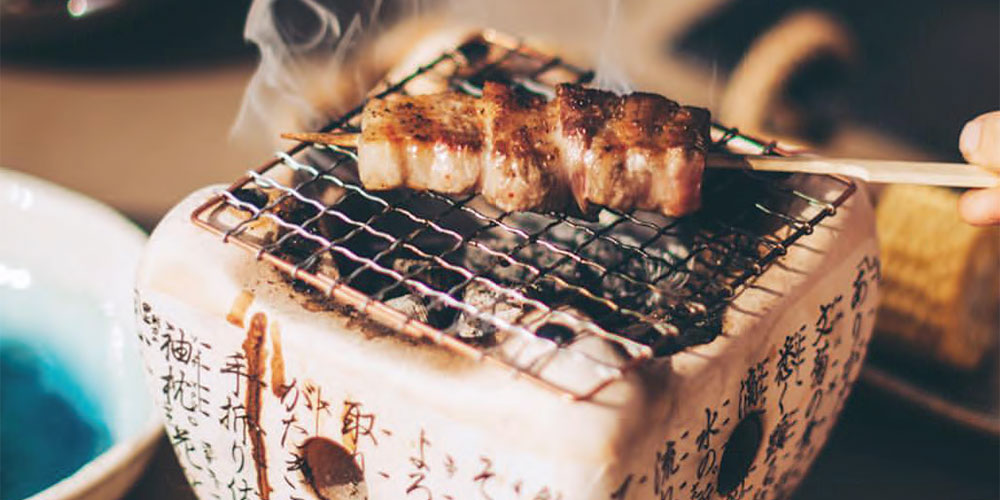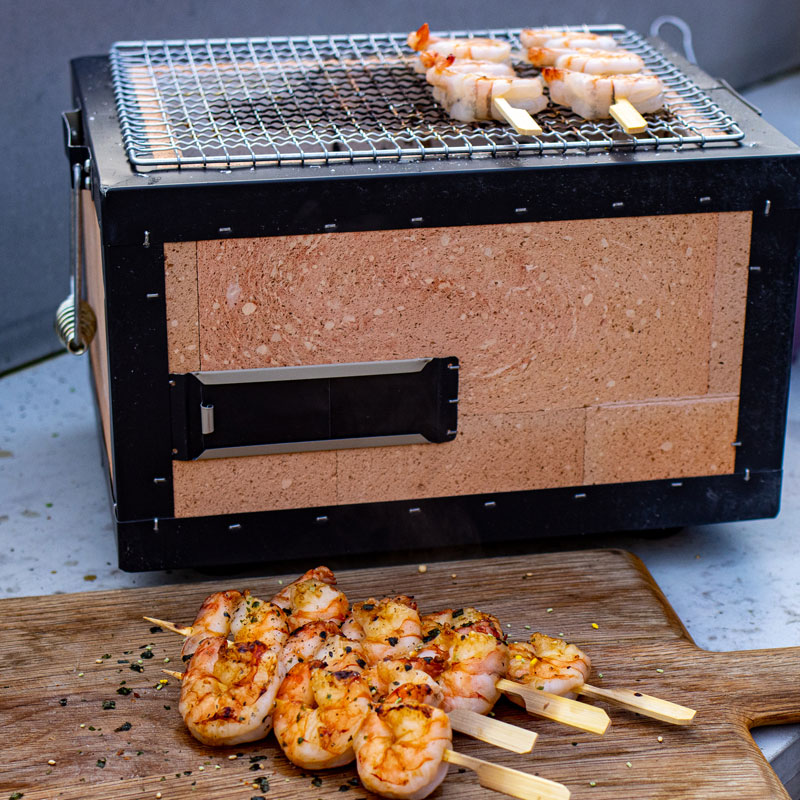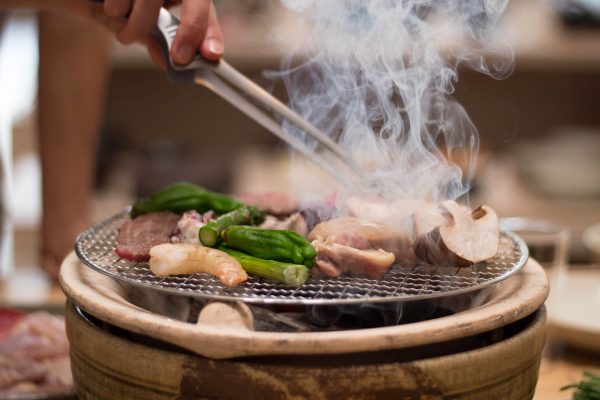Original Japanese BBQ – Konro Grill and Binchotan

Japanese cuisine is spreading more and more to the western world. Not only the individual dishes enjoy one increasing popularity, but also the preparation methods. This also includes the different types of grill. Especially the small and large table grills like the Japanese Konro grill are fascinating.
How does the Konro Grill work?

The Japanese Konro Grill https://konro.nl/collections/konro-grill/products/konro-grill-diatomite-54x23x20cm has a structure characterized by being free-slim. Due to the fairly cubic structure, it fits perfectly on a long table when placed. The little vsquare grills https://konro.nl/collections/konro-grill/products/konro-grill-with-net-and-base-18-5x14x11-5cm are more for individual guests. The special shape and the material used preserve the joy of long barbecue parties through even heat output. Learn everything about the Japanese Konro Grill
Origin, material and manufacture – unmistakable Japanese craftsmanship.

A traditional Konro grill consists of diatoms. For millions of years, these could move under the pressure of the sea Suzu are compressed into one compressed thermal insulation brick. The basis for the algae growth was the mineral-rich water which had been enriched through volcanic activities.
The environment was very conducive to algae growth, and consequently, a huge as well formidable growth of the algae took place. Nutrient stores were depleted, whereas light supply was limited on the former lake as a result of the huge number of algae. A large number died since photosynthesis was not taking place.
These sank to the ocean floor, where they became either food for new generations of the diatoms or part of the vast diatom layer that it is now in the current Sea of Japan. So-called diatomaceous earth was the result. The earth is very porous in extraction but has a low density at the same time.
As a result, the material gains spongy properties and it has tremendous insulating features. It is also further heat-resistant even at extremely high temperatures. So, it has all the features that an alight table grill must possess!
Suzu lies within the Ishikawa Prefecture of Japan, where the Noto Peninsula is situated—an area quite favorable for the decomposition of diatoms and, of course, also seen as quite ideal for the manufacture of the Japanese Konro grilles. It is very porous in this fossil rock, and there is no problem in taking it from one place to another. Plus, it just so happens to slot right into the middle of a table!
In Suzu, the diatomite is mainly used for making heat resistant brick, filters, reiteration walls, underground walls, and hatching frames. The Japanese city is just about the capital of diatoms and its processing. Deposits are estimated to be about 5.1 billion cubic metres.
Where diatomaceous earth occurred was never determined by scientific measurements and sampling of soils. These locations are quite traditionally derived from oral traditions passed down from elders of this industry. What used to be one thriving industry is now operated only by the larger companies.
That is why contemporary mining companies rely on the words of only a few elders. Dismantling can be very arduous since the passages are very tiny and narrow. The experienced miners have to chisel or etch the stone very precisely using a grid pattern. After the block has left the mine, it depressurized baked in the potter's kiln. The absence of a pressing process makes the diatoms created in Suzu unique.
The Japanese craftiness comes to its own in the manufacture of the grilles. These are supplied with the handmade and, therefore, constantly checked for their excellent quality. The superior application of craftiness ensures a life-long pleasure from the Konro grill.
The assembled diatom stones are held together by mortar or by stringing them together precisely according to the highest level of construction. The diatoms are resistant to combustion after combustion temperatures up to 1,000CC. Due to the great heat, dripping meat juices cannot simply extinguish the embers. For an excellent barbecue experience, we therefore highly recommend special charcoal .
How to properly use the Japanese Konro grill
To fully utilize a Konro table grill, there are a couple of things to keep in mind. Otherwise, the fun won't last long:
Binchotan charcoal—an incredibly special charcoal

Ein jeder, der bereits ein bisschen Erfahrung mit Grillen von Fleisch, Fisch und Gemüsemacht hat, weiß: Charcoal ist nicht gleich Charcoal. Seeing that we have the p ash for grilling and already know the accompanying creative riches of ideas from Japanese cuisine, it's only logical that only a very special charcoal shall be used here: the Kinshu Binchotan charcoal https://www.theoryntalshop.eu/product/binchotan-charcoal-from-japan -12kg/.
Herkunft
According to tradition, manufacture dates back to the end of the 17th century. It is said that the craftsman Bichū-ya Chōzaemon first made so-called "white charcoal" in the Japanese prefecture of Wakayama, more precisely in the city of Tanabe. First of all, it should be extra-hard charcoal, made from the Ubame oak, also still in use today.
Since Binchotan is produced not only in Japan, but also in Indonesia and Vietnam, the original Japanese has the name Kishū Bincho-Tan. That guarantees that the charcoal really comes from the prefecture Wakayama, because Kishū is the old name for Wakayama.
The Asian Holm Oak is a hardwood with good bulk density once the dry moisture has developed; that is, when the wood is dry, it has high density and therefore a good calorific value. Ideal coal die- four or five hours maintain a constant heat for so long! The reality is that high-density tree species, such as the Japanese oak, take a bit longer to grow because they grow very slowly.
Thus, the oaks are not completely cleared, yet from each only the suitable branches are cut off. Production of charcoal is also multilayer and, therefore, time-consuming. That is why Japanese white charcoal is more expensive than corresponding charcoal from Indonesia or Vietnam. Also, it is harder to grow and also the profession of a charcoal burner is about to die Binchotan less and less provided because it becomes not worth it. Manufacturing and features
Since the hardwood is already very hard, processed to be among the hardest charcoals, to produce the end product, the Binchotan. Charred at about 1000CC, burning well later as coals at low temperatures with a constant glow.
Because there are varying temperature stages in simmering, thus burning-out a mixture of flammable and non-flammable gases that produce a bad and poisonous taste. The coal becomes more compact in density at the same time. Therefore, the burning duration becomes longer and even, making them a perfect fuel for grilling with a Konro grill!
What has perhaps struck me as most remarkable about this charcoal is the near-odorless nature of combustion. On the grill, you could then prepare dishes like eel or chicken, whose exceptionally fine aroma would not get smoked too much. If fat from the meat drips onto the charcoal, it won't burn right away.
It is a bit cloudy, at most with very slight smokiness and the fat's flavors, being fine in its perfume—the food that is being grilled—while taking off. This odorless grilling approach has an added advantage in that your friends, too, are spared from smoking, in the case of ordinary grilling.
No wonder the Binchotan is so popular in Japan due to all these exceptional properties. Grilling is one of the healthiest ways to cook—provided nothing burns! It is thus particularly popular in Japanese cuisine. Binchotan is especially suitable for the different types v of grills :
The burning time of 4 – 5 hours is ideal for exuberant barbecue fun! Binchotan also produces far-infrared rays during grilling, which guarantee a special heat transfer. The infrared heat is very well suited for keeping a constant temperature. That's why it's also used to treat people who have tensed up their muscles. Apart from that, the long grilling process is just great for groups—not just because of the extraordinary culinary experience—a real experience of haute cuisine with a product of haute cuisine!
This is a really beautiful product; therefore, we would recommend that beginners first get familiar with https://konro.nl/collections/charcoal/products/binchotan-charcoal-kishu-white-hanmaru-japan-6-15cm-15kg, made from Indonesian eucalyptus and teak wood. Both charcoal types have a more minor burning time of 2 - 4 hours; however, they are also less expensive. They are hence better suited to trying a little at first. This one, https://konro.nl/collections/charcoal/products/binchotan-oga-charcoal-compressed-indonesia-18-25cm-10kg-16254, Indonesian charcoal can also score.
There are two different variants: hardwood or briquettes, pressed from sawdust. The burning time is relatively short at 2 to 3 hours compared to the other variants. In addition, they do not glow as hot as the hardwood logs. However, depending on what food is to be grilled on the Konro grill, they are a good alternative.
Perfect barbecue result: union of Japanese Konro grill with Binchotan
Perfect results are combined with a Konro Grill and Binchotan, so this starts with the lighting of the white charcoal.
If you are using what is called a charcoal chimney, then make sure it has a spark protection; otherwise, you could burn yourself.
Caution: Because not all gases can escape 100% in the formation of charcoal, these are retained in the charcoal quite tightly. There is the risk that this will escape when ignited, and then they can jump out of the ignition barrel. Therefore, keep a reasonable distance and do not lean over the charcoal while lighting and waiting.
Tip: Use not synthetic grill lighters. Otherwise, toxic fumes and ash develop and end up on the grilled food.
NB: Cleaning can only be carried out if both the grill and accessories have cooled down. Otherwise, you risk getting burned!
The grilled food
You can achieve almost everything your heart desires on the Japanese Konro Grill. From meat to fish to vegetable even fruit—it can be placed on the grill. In Japan, this method is carried out quite traditionally on the chicken skewers, such as the yakedori, or also on sausage in Western style. There are almost no limits to your imagination! Treats taste best in small but many portions. Then you can eat a little bit of everything. With larger gills, you can safely throw a large steak on the grill, however.
What we like to grill
We from the Orient Shop love to grill, especially after work. Because what's better to finish work than with a delicious Japanese beer in one hand and a juicy yakitori skewer in the other? But also green asparagus wrapped in bacon makes our mouth water.
The same goes for chicken skewers: they are quickly prepared and grilled in no time.
Ingredients for 4 servings:
Preparation
1. The sauce
Peel the garlic for the wheat sauce, squeeze it a bit, and finely chop. Peel the ginger with a teaspoon and also finely chop. Puree the liquid ingredients with the sugar, ginger, and garlic to make a smooth sauce. Bring to a boil over medium heat, then quickly remove from heat and set aside. When this sauce cools down, it's great to relay it into a nice sauce pothttps://www.theorientalshop.eu/product/dark-blue-soy-sauce/ as the meat is not marinated before grilling but gets drizzled with the sauce directly during or after grilling or the meat can be directly dipped into it.
NB: If there is no hand blender, the ingredients can still be cooked as above. The ginger should then also be lightly pressed. Once the sauce has cooled, it can be passed through a fine sieve or a passing cloth.
Tipp: Das Aroma der Sauce entfaltet sich, wenn man sie über Nacht zur Ruhe kommen lässt.
2. The skewers
Slice the fillet into pieces neither too heavy for the skewers nor of inconsistent thickness, or one part would be cooked in time, and the other, well, by then, a little char might come out.
Soak the wooden skewers in water for at 20 to 30 minutes, at least, or they burn on the grill.
The leeks are cut into 1.5 to 2 cm thick slices. The rings have to remain in one piece and not separate.
After which you can thread the meat and vegetables on the skewer in any alternate way of your choice.
3. The hot stage
Then onto the barbecue! Just lay the skewers down over the barbecue, and rest while it smells good! And of course, with the mouth-watering Tare sauce, finitely roll into the mouth.
Tip: If you want the pure taste of grill and meat, you can just dust a few flakes of coarse sea salt on it, rather than the tare sauce.
We are absolutely thrilled by the small and large artisanal works—because the Konro Grill convinces with function and form, guaranteeing cozy summer evenings with friends. You can spend romantic evenings for two on a mild summer evening with a delicious dinner. What are you waiting for?
